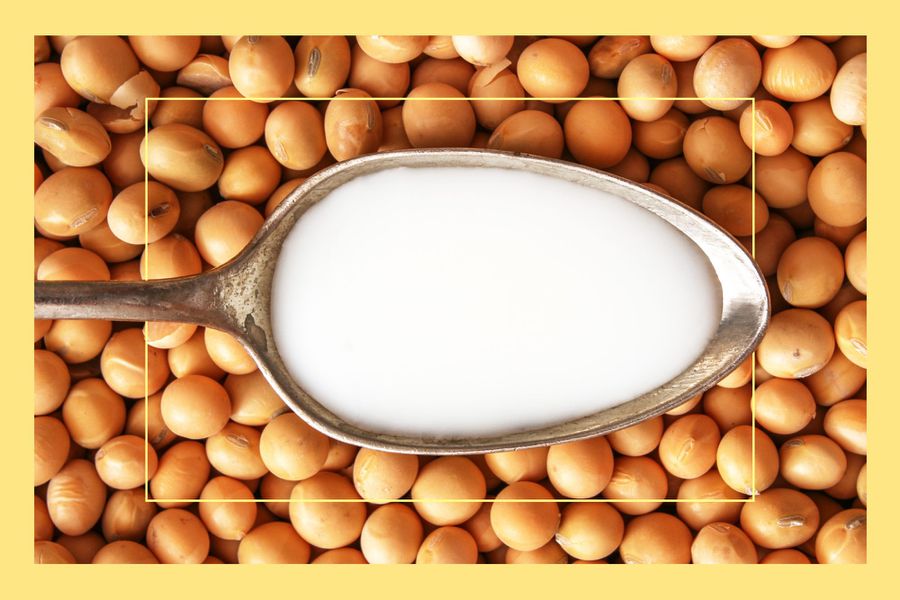
When the barista at your local coffee shop asks you which type of milk you’d like in your latte, you might utter the first beverage that comes to mind, without any rhyme or reason. After all, choosing just one milk out of the ever-growing list of dairy-free options can feel incredibly overwhelming.
But once you learn soy milk's nutrition facts and serious health perks, it might just become your go-to — and you'll never stumble to answer the café employee again. Here, a registered dietitian breaks down the key soy milk benefits and shares ideas on how to get your fill — besides just drinking it straight-up.
What Is Soy Milk?
It’s a dairy-free, plant-based beverage made by soaking soybeans in water, pureeing them, and straining out the liquid, says Alex Caspero, M.A., R.D., a registered dietitian and plant-based chef in St. Louis. Soy itself has been a dietary staple in Asian cuisines for thousands of years, and soy milk, in particular, has historically been consumed widely in China, Japan, Korea, Singapore, and Thailand, according to research published in the journal Foods. Since it has a similar nutrient profile to cow’s milk, it’s become a popular dairy alternative for vegetarians, vegans, and folks with lactose intolerance in Europe, Australia, and the U.S.
Soy Milk Nutrition Facts
Compared to other dairy-free bevvies on the market (think: almond and oat milks), soy milk often stands above the rest because it has an “impressive nutrient profile,” says Caspero. In just one glass of soy milk, you’ll score healthy fats, muscle-building protein, and brain-boosting micronutrients (think: vitamins and minerals), she explains. “It’s just a really good, nutrient-dense milk option,” she adds.
While the exact micronutrient profile of soy milk varies from brand to brand, depending on whether the beverage is fortified with additional vitamins and minerals, the primary soy milk nutrition facts remain largely the same. Here, the nutritional profile of 1 cup of unsweetened, fortified soy milk, according to the United States Department of Agriculture (USDA):
Soy Milk Health Benefits
May Improve Heart Health
While the high-fat content in cow’s milk is responsible for giving the drink its creamy mouthfeel, it’s also one of the beverage’s downsides, says Caspero. Dairy products are often naturally high in saturated fat, the type of fat that can raise low-density lipoprotein (aka LDL or “bad”) cholesterol levels and, in turn, increase your risk of developing heart disease and stroke, according to the National Library of Medicine (NLM).
The primary fats in soy milk, on the other hand, are the polyunsaturated and monounsaturated kinds — both of which are considered to be “heart-healthy” fats, says Caspero. In fact, research shows that consuming unsaturated fats in place of saturated fats (and staying within the USDA’s recommended cap of 20 to 35 percent of daily calories coming from fat) is linked with a reduction of both total cholesterol and LDL cholesterol levels. Consequently, it can decrease the risk of developing cardiovascular disease, according to the U.S. Food and Drug Administration (FDA). Translation: Sip on a cup of soy milk, and you’ll score nearly 4 grams of fat that may benefit heart health and gives the drink that satisfying, velvety texture.
Builds and Repairs Muscle
Another reason soy milk is considered the crème de la crème of alt-milks? It packs nearly the same amount of protein — 7 grams per cup (15 percent of the recommended dietary allowance) — as the cow-derived kind, which offers 8 grams per serving, says Caspero. In comparison, almond milk provides less than 1 gram per cup, according to the USDA. And this soy milk benefit can have full-body effects, as protein helps build and repair cells, tissue, and muscle, ensures proper growth and development, and assists in body processes such as blood clotting, fluid balance, and more, according to the FDA.
As with cow’s milk, the protein in soy milk is considered to be “complete” protein, meaning it contains sufficient amounts of all nine essential amino acids, which can be obtained only from food, that are needed to make new protein in the body, according to the Harvard School of Public Health (HSPH). Specifically, soy milk is rich in lysine, an essential amino acid that aids in the formation of collagen, and can be tough to score while following a plant-based diet, says Caspero. “So getting a serving of soy milk a day is a really great way to meet [your needs for] the amino acid lysine,” she adds. (That said, even if you don’t sip on soy milk daily, you can still get your fill of amino acids — and fuel your gains — by eating a variety of protein-filled plant foods.)
Supports Brain Health
Aside from those key macronutrients, soy milk also contains high amounts of choline, says Caspero. “Soy is the richest source of choline in a plant-based diet, and cow’s milk does not contain large amounts of it,” she adds. Once consumed, the under-the-radar nutrient is converted into the neurotransmitter acetylcholine, which plays a role in memory, mood, muscle control, and other brain and nervous system functions, according to the National Institutes of Health (NIH). In fact, a study of nearly 1,400 adults found that folks who consumed higher amounts of choline had better verbal and visual memory than those who consumed less, according to the NIH. The good news: By sipping on a cup of soy milk, you’ll score nearly 14 percent of the RDA for choline.
Improves Digestive Health
Fiber likely isn’t at the front of your mind when you’re on the hunt for a cereal milk or coffee add-in, but it’s one of soy milk’s surprise benefits. For each cup, the beverage offers nearly 2 grams of fiber (7 percent of the RDA), which is the part of plant foods your body can’t digest or absorb. Cow’s milk, on the other hand, is completely devoid of fiber since it’s an animal-based product, says Caspero. And this bonus nutrient can mean you spend less time on the porcelain throne: Fiber helps increase the weight and size of your poop and softens it, making it easier to pass and minimizing the chances of constipation, according to the Mayo Clinic.
How to Buy and Use Soy Milk
If you're ready to give the dairy-free drink a shot and start scoring all of soy milk's benefits, there are a few points to keep in mind while you shop. Along with selecting a tasty milk that you actually look forward to drinking, Caspero recommends choosing a soy milk — or any alt-milk, for that matter — that's fortified, meaning certain micronutrients have been added to the drink. "You want to ensure that any of the benefits that regular, traditional milk provides is found in your milk alternative, and that's why I think fortification is so important," she explains.
While most refrigerated plant-based milks are fortified, there currently isn’t a standard of which nutrients to include and how much of them, says Caspero. Some brands will add vitamin A (which supports normal vision), vitamin B12 (which keeps your blood and nerve cells healthy), and vitamin D (which helps your body absorb calcium) in various amounts, she explains. Still, “the majority of them contain the same amount of calcium,” she adds. “There are really no benefits to going above 500 milligrams of calcium in a serving, just because our body doesn’t absorb more than that at one time. So most of the plant-based milks fall between 300 milligrams, which is what you’d find in a glass of cow’s milk, and about 450 milligrams per cup.” (Reminder: Calcium makes up the majority of bone and teeth structure and helps keep tissue strong and flexible, according to the NIH.)
Aside from fortification, you’ll also want to opt for a soy milk that’s unsweetened, suggests Caspero. While soy milk naturally offers a small amount of sugar, sweetened versions also contain added sugar (think: cane sugar) that contributes calories but no additional nutrients to the beverage, according to the Office of Disease Prevention and Health Promotion. And consuming these sugars in excess can lead to health problems such as diabetes and heart disease, according to the Centers for Disease Control and Prevention.
Soy Milk Recipe Ideas
Thanks to its mild flavor profile and satisfying texture, soy milk is easy to incorporate into your everyday routine — and you may not miss dairy milk one bit. "I like soy milk because I think it has an easy, neutral taste," says Caspero. "Also because soybeans naturally contain some fat, it also has a fattier mouth feel, which is very similar to dairy milk." To nab all those soy milk benefits, steal these meal and drink ideas.
In oatmeal. Soy milk is Caspero’s go-to cooking liquid for oatmeal, which she makes practically every morning for her family. Once you’ve made your porridge, top it off with nuts and seeds for an extra boost of protein and healthy fats.
In smoothies. To give your smoothie a creamy texture without dairy, use soy milk as your liquid.
In baked goods. Since soy milk has an indistinct flavor, it works well as a cow's milk substitute in baked goods, such as muffins, cakes, and biscuits, and savory recipes, including pasta sauces and salad dressings.
In coffee. If you’re a hardcore hater of black coffee, lighten up your morning cup of Joe with a splash of soy milk. Making iced coffee? Freeze soy milk in an ice cube tray and pop a piece or two into your glass for a chilled beverage that won’t become watered down. (Next up: What Is Pistachio Milk, and Is It Healthy?)



































